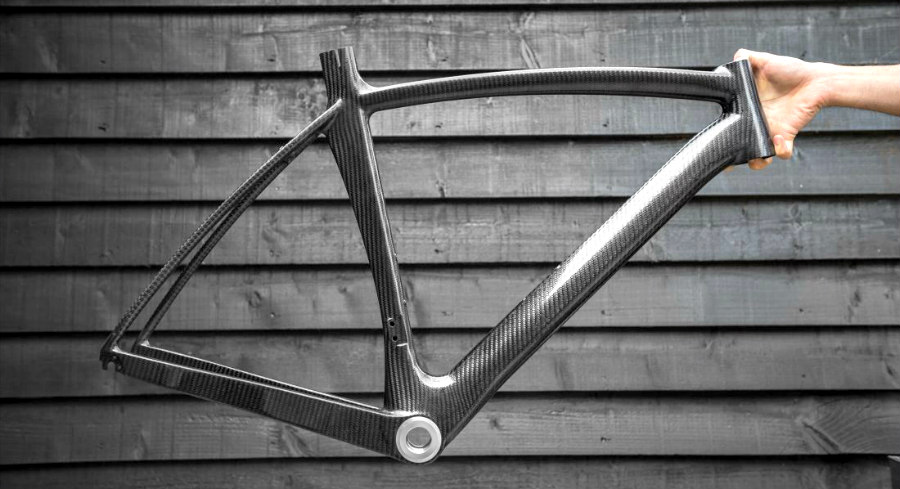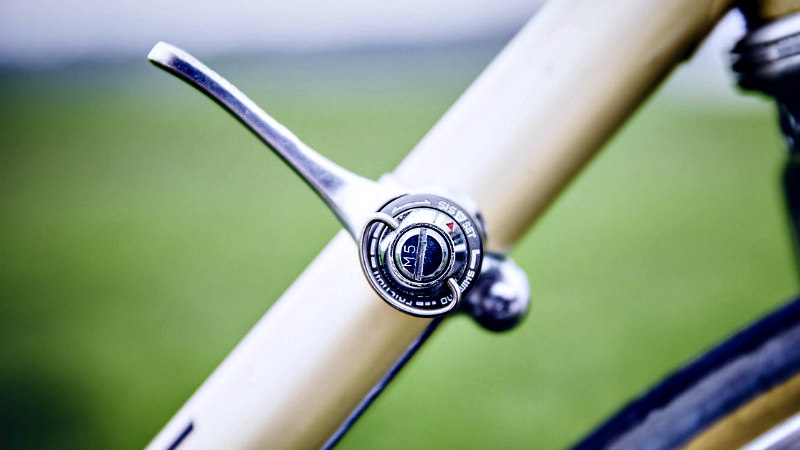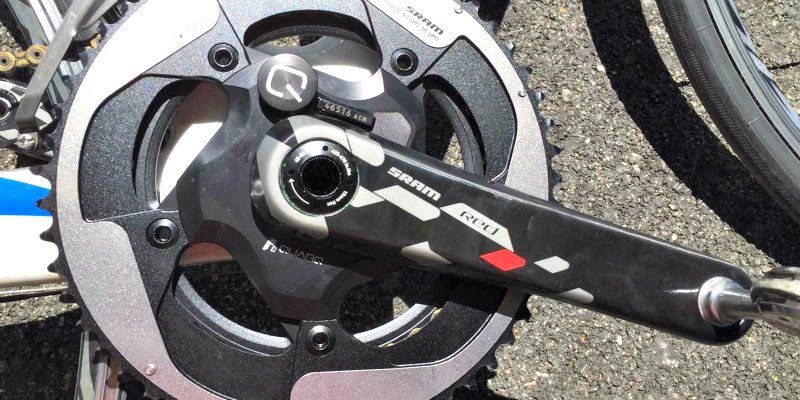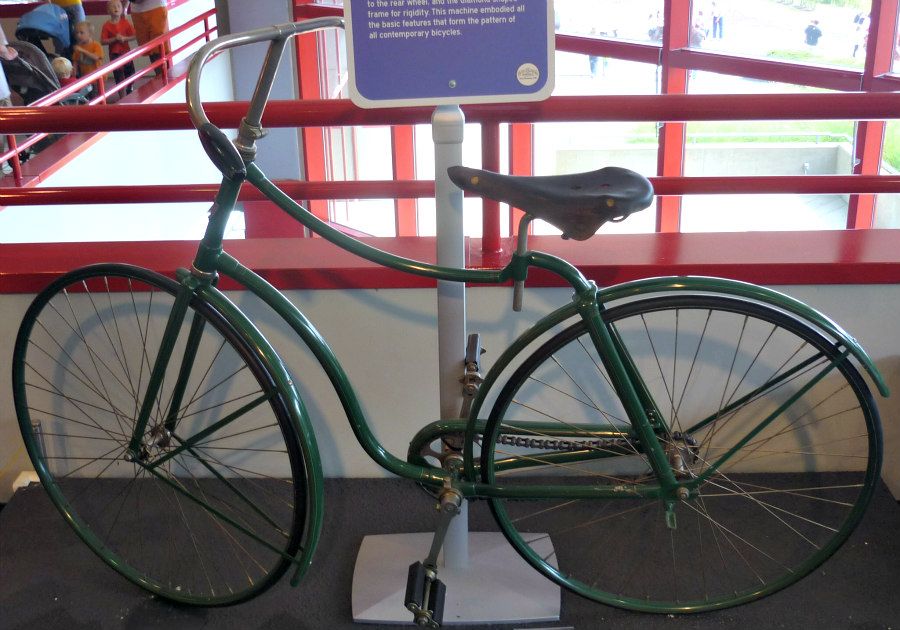https://youtu.be/iQ7ys643Npg
The first cycling test in the history of which you have a documentary record dates back to 1868. The 7 cyclists who took part in the test, held in a circuit of just over 1 kilometer the outskirts of Paris, carried wood bicycles with wood iron wheels and fixed pinion. Nothing to do with the very light carbon machines with 11 -speed cassettes and electronic change of today.
There is no doubt that road bicycles have evolved considerably since then. As competition cycling grew, it was also made by the demands for having increasingly light and versatile bicycles. Gradually the brands were incorporating technologies and developing patents that made the cyclist's life easier.
But of all the great innovations that cycling has experienced, in what manufacture bicycles, which have meant a before and after? Here are the 10 essential innovations that have made history in the road cycling industry.
1- Chamber tires
Today it is unthinkable for someone to take the departure from the Tour de France with a bicycle equipped with wooden tires and iron covers. However, until the end of the 19th century the wheels of the bicycles were like that. Very heavy, very rough, little maneuverable and with a high degree of fracture in case of a blow (the wood is easily split in case of accident at high speed).
In 1887 John Dunlop developed the first modern tire. Changing the stiffness of iron and wood for the comfort of rubber supposed the first great revolution of cycling, since it allowed cyclists to roll more comfortably and at a faster rate.

If you want to get an idea of the degree of revolution that meant the invention of Dunlop, in 1869 it was played between the localities of Paris and the first route test that is recorded. The winner, the British James Moore, took 10 hours and 45 minutes to complete the 123 kilometers of the route.
From 1890 the cyclists soon incorporate rubber tires into their bicycles, especially because Michelin perfected Dunlop's design and launched the first disposable cover. This helped the first great classics be born, such as
Lieja-Bastogne-Lieja wave
Paris-Roubaix.
More than 125 years after the wheels with rubber chamber appear, Dunlop's innovation is still valid. There have been some technological advances, such as the tubeless in mountain cycling or the introduction of the wheels with tubular. But in broad strokes the wheels of the route bicycles continue to based on an air inflated under a cover.
2- The rear deviation
Until 1937, when deviators were introduced for the first time in the Tour of France, it was common for the rear wheels to have two pine nuts of different size, but one on each side of the axis. The usual way to change the development of the bicycle was to get out of it, disassemble the wheel, rotate it and reassemble it again.

This limited the number of speeds that two bicycles could have, and forced cyclists to have to get off at the beginning of each port to place the wheel in the shortest development position. When the descent began they had to turn the rear wheel to align the plate with the smallest pinion side.
As we said before, the first edition of the Tour of France in which a change system was used that did not force the cyclist to get out of the bicycle was that of 1937. However, the diversor had already been invented several years before. In the first decade of 1900 several gear change systems appeared, although its operation was far from the current ones. They consisted of rods that moved the chain to move it from one pinion to another.
It was in the 1930s when the cable drive changes system appeared by parallelogram diverter, which was improved in mid -1960 thanks to a patent from SuTour.

But the great innovation in terms of change groups occurred in 1985, when Shimano introduced his synchronized change system, which is the one that remains today. In addition to the Japanese manufacturer, the other two major manufacturers of change groups are the American brand SRAM and the Italian Campagnolo.
Shimano and SRAM have change groups for road and mountain cycling, while Campagnolo only manufactures changes for route bicycles.
3- Rapid closures
Imagine the following situation: you are uploading the Tourmalet in the middle of the Pyrenean stage of the Tour de France. Suddenly you suffer a puncture and you have to get off the bicycle to change the camera. Or you simply need to change the march to start climbing, as was the case until the invention of the deviators.
With cold, rain and wind you have to challenge the screws that hold the wheel axis. Not only is it uncomfortable, but it is a time expense. Well, this was usual until in 1927 Campagnolo patented a system that allowed the release of the wheel with a simple lever mechanism.

That innovation meant the introduction in cycling en route of rapid closures, which today are everyday not only inside the great squad, but in the vast majority of bicycles.
Rapid closures have helped save time and effort when replacing a punctured wheel, avoiding the annoying task of having to loosen and tighten nuts with a fixed key or an English key.
4- Automatic pedals
In the 1980s Look was inspired by the ski boots fixing system to launch the first automatic pedals. Until then the cyclists fixed the foot to the pedal by means of a belt system or an aluminum harness.
Sometimes this was dangerous, since in case of accident or loss of balance it was not easy to remove the foot from the pedal to rely on the asphalt and avoid the fall.
The idea of look to create a rapid closing mechanism that will facilitate anchoring and disagreeing the foot to the pedal was a revolution in several areas. The first, the security. The new automatic pedal system made the task of getting the foot out of the pedal without having to unravel straps.
The second factor by which automatic pedals are one of the 10 great innovations of the road cycling has to do with performance. Having the foot anchored in a fixed position on the pedal helped improve the efficiency of the pedalada, allowing cyclists to better take better advantage of each pedal blow.

The first professional cyclist who used this anchor system in the Tour de France was Bernard Hinault in 1985. Hinault got his fifth tour carrying automatic pedals.
5- The counterreloj couplings
In the Tour of France of 1989 there was a historical fact. Never before the winner of the gala round had proclaimed champion with a margin of difference as narrow as the one that the American Greg Lemond got before the Frenchman Laurent Fignon.
Fignon reached the last stage as a leader, with 50 seconds of difference over Lemond. Everyone assumed that the Frenchman would be crowned champion of the Tour de France in the Eliseos fields of Paris. It was only enough to keep those 50 seconds in the final counter of 24.5 kilometers with which the round was closed.
No one foreshadowed that Lemond was able to snatch the yellow jersey with such little margin of mileage. But the American surprised everyone rolling to the highest pace in a counterreloj played to date in the entire history of the gala round. Its average speed was 54,545 kilometers per hour carrying an aggressive development of 54x11.
Greg Lemond not only won the time trial, but also proclaimed the winner of the Tour de France with 8 seconds of difference with respect to the French. He had put Fignon 58 seconds on a 24 -kilometer tour!

It was the triumph of aerodynamics. Le Mond took the time trial with a bicycle to which he had incorporated some Cott brand counts.
The couples were a relatively recent invention. They had been used since 1987 in triathlon tests, but never before had been used in road cycling.
The UCI regulations said nothing about the use of couples, so Lemond decided to use them in the two counterreloj stages of that tour next to an aerodynamic rotation helmet that provided less air resistance.
He won both stages: the fifth and the last one, getting a comeback that seemed impossible and achieving the closest victory of the entire history of the Tour of France. Since then the couples became an essential element for the specialists against the chrono and have helped be beaten records and achieve greater efficiency in tests and counterreloj stages.
https://youtu.be/rWyfb3H7LEg
6- Carbon pictures
Almost since the beginning of cycling, one of the great technological challenges of the cycling industry has been to manufacture increasingly light, resistant and comfortable bicycles.
When aluminum replaced steel as the main material for the elaboration of paintings, there was a remarkable improvement in this regard. Aluminum is lighter and more flexible, which not only results in a lower weight of the bicycle, but also in the possibility of creating pictures with more curved lines.
But the great revolution of the materials came with the use of carbon fiber. It is light, resistant to corrosion and offers extraordinary solidity. In addition, one of the great advantages of carbon with respect to metallic materials is that it can adapt to virtually any form and geometry.
This versatility and flexibility was an advance for the development of more aerodynamic bicycles, with geometries that combine curved and straight lines to provide greater comfort in driving and lower air resistance.

Lightness, rigidity, aerodynamics and comfort are precisely the four major qualities that most value cyclists of a bicycle. No other material combines all of them than carbon fiber.
In addition, depending on how carbon fibers are available, paintings that have different degrees of stiffness and flexibility in different sections of each tube can be achieved. In this way, the forces exerted during pedaling can be used more efficiently, preventing the power of the pedal blow from dissipating and providing faster and more comfortable driving.
The use of carbon fiber in the manufacture of pictures and bicycle components is a relatively recent technology. Although manufacturers already speculated with the possibility of applying it in the 1970s, it was not until the mid -1980s when they entered the scene.

Kestrel was the brand that designed the first carbon picture in 1986. Three years later, forks made with this material and in 1990. Since then the use of carbon fiber has been widely extended among the main bicycle brands, they offer in their high -end monocasco segments. These are made of a piece from a single mold.
7- STI camshafts
Until 1990, to make a change of marching by driving the front diversor or the rear diverter, the cyclists had to separate a hand from the steering wheel. Since in the 1930s the diverters with cable drive began to be used, the mechanism with which a larger or smaller pinion was placed was the same: to act a lever located in the box.
But in 1990 Shimano introduced a different mechanism. It consisted of a small lever integrated in the brake handle. With a simple gesture from the hand you could select an upper or lower march. It was no longer necessary to take off the handle of the handlebars or take off the road from the road to change their march!

The STI -type cams (acronym for Shimano Total Integration) represented a triple advance in road cycling. First because changing march was more comfortable. Second, because it was no longer necessary to modify the driving position to act the divers, which improved aerodynamics. And third because rolling in a group became safer.
In addition, it ended one of the most frequent problems when executing the changes: having to reduce pedaling cadence. With the changes operated by the classic lever in the box, it was common that to make the adjustment at a higher or lower speed, it would have to stop pedals. Otherwise the chain could be released.
However, with the STI cams, it was no longer necessary to stop pedaling.

Today camshafts (evolved from the STI of Shimano and the Ergopower of Campagnolo) are the standard in most bicycles of medium and high ranges. And practically monopolize the international platoon, with some exception.
Lance Armstrong, for example, used to install on the bicycles used for the mountain stages a STI system to change the cassette and a lever in the tube for plate changes. The reason was that he managed to lighten the weight of his bicycle in 200 grams, since the camshafts in the handles have more pieces than the tube levers and weigh more.
8- Electronic change groups
They have been with us for a short time, but in the high competition they have already become essential. And more and more amateur cyclists begin to bet on them. We refer to electronic change groups.
The first change groups were activated by a rod system. Shortly after the parallelogram diverter that he used as a mechanism to change the tension of a cable was introduced.
This mechanical system prevailed practically invariable until just a few years ago. In the 2000s both Shimano and Campagnolo began experimenting with electronic changes. The operation is as follows: To change the dish or crown it is not necessary to print any tension in the cable, but it conducts an electrical impulse with the instruction for the diverter.

Two are the main advantages provided by electronic changes. On the one hand there is a lower wear of the change cables, which requires less maintenance and prevents having to check shirts and wiring with some regularity.
On the other, the drive is much softer than the mechanical and extraordinarily precise version. Once it is calibrated, it is very difficult for it to be mismant (unless it receives a strong blow to a fall or an accident) and a slight click is enough to change the speed in milliseconds.
As for disadvantages, electronic changes depend on a limited duration battery. Although current batteries are much more durable than those of the first versions (and more compact, passing through the problem of where to place them), it is necessary to control that they have an adequate level of load, it will not be that you are without power Change march in the middle of a march or a race.

On the other hand, they are also heavier and more expensive. In some cases until twice as expensive as the same change group model in its mechanical version. In any case, it is still a technology still recent and surely evolve in the coming years to achieve more light and affordable transmission systems.
In 2009 Shimano took the first generation of his electronic change group DI2 for Ultegra and Dura-Ace ranges. Two years later Campagnolo did the same with his EPS transmission, which is available for super record, record and chorus ranges. SRAM has been the last of the three major change manufacturers in launching an electronic version. In your case, it is also a wireless change.
9- Power meters
Aerodynamic helmets and coupling couples were not the only technological innovations that Greg Lemond tested in the 1980s. The North American cyclist, who won three Tours of France and two world championships of the world of cycling between 1983 and 1990, was the first professional cyclist to try a power meter on his bicycle.
Power meters have become such a fundamental instrument in professional cycling as pulsometers in athletics. Because they not only measure the power that the cyclist prints in each pedaling, but also allow to calculate the optimal pedaling cadence depending on the type of route and objective to be achieved. In this way the effort is optimized and better results are achieved.
Before the power meters reached the international platoon, the way to dose the effort was through the sensations that the cyclist had. This intuition component was not totally reliable.

However, with the use of power meters in both training and competition, the cyclist faithfully knows what their maximum, minimum and medium performance thresholds are. Hence, they have become very popular in counterreloj tests, long distance triathlons and mountain stages.
The power meter is not an innovation that has improved the driving of a bicycle, but it is a significant advance when the use and optimization of the pedaling cadence.
Some teams, such as Team Sky, have led the use of power meters to a new cycling training paradigm. Combining the data provided by this instrument with the physical parameters of the cyclist and the aerodynamic position above the bicycle, they have created pedaling models and patterns tailored to each corridor.
10- John Kemp Starley's bicycle
Each of the innovations that we have seen before have meant an evolution within the cycling en route. But all of them have a common denominator: they apply on a bicycle whose basic transmission and geometry mechanism has been practically invariable since the late nineteenth century.
Possibly the main innovation experienced by road cycling took place in 1885, when John Kemp Starley designed the so -called
Safety Bike ('Segura bicycle', in its Spanish translation).

Until then the most widespread bicycle model was that of the so-called Penny-Farthing, the high wheel bike invented in 1873. This type of bicycle, whose front wheel was three times larger than the rear, had the center of gravity very high very high and was very prone to overtur.
The accidents were very frequent and, given the height at which the cyclist should be climbed, the injuries were very spectacious.
This was how in 1885 John Kemp Starley designed a more stable and safe bicycle (hence his name). Both wheels were the same size, the structure was based on a diamond -shaped box where the pressures and weights were distributed using a tubular system, and had a chain gear transmission mechanism. Exactly, as is the case today.

In addition, the center of gravity was lower and cyclists could put their feet on the floor without getting off the bicycle, which prevented numerous accidents.
The design of this 'safe machine' caused the bicycle to have a sales boom in the later years and cycling races began to be increasingly popular. In addition, since its original structure inaugurated the era of modern bicycles, it is probably the most important innovation in the history of cycling en route.
There is no doubt that the road bike is a vehicle in continuous evolution. Every time new engineering solutions are willing to revolutionize the way to roll or compete.
Those that we have broken down in this report are what we consider that they have had a greater weight, whether in the form of structural improvement, security or innovation applied to the world of competition.
But surely we have left others. If you consider that there is any worthy of appearing in this ranking, do not hesitate to indicate it through the comments. For example, Tom Boonen considers that
"Disc brakes are the greatest innovation I have seen on a bicycle". Perhaps in a short time, when they are commonly used in the UCI calendar and show that they provide a significant improvement, more people will end up thinking just like the Belgian cyclist.
 If you want to get an idea of the degree of revolution that meant the invention of Dunlop, in 1869 it was played between the localities of Paris and the first route test that is recorded. The winner, the British James Moore, took 10 hours and 45 minutes to complete the 123 kilometers of the route.
From 1890 the cyclists soon incorporate rubber tires into their bicycles, especially because Michelin perfected Dunlop's design and launched the first disposable cover. This helped the first great classics be born, such as Lieja-Bastogne-Lieja wave Paris-Roubaix.
More than 125 years after the wheels with rubber chamber appear, Dunlop's innovation is still valid. There have been some technological advances, such as the tubeless in mountain cycling or the introduction of the wheels with tubular. But in broad strokes the wheels of the route bicycles continue to based on an air inflated under a cover.
If you want to get an idea of the degree of revolution that meant the invention of Dunlop, in 1869 it was played between the localities of Paris and the first route test that is recorded. The winner, the British James Moore, took 10 hours and 45 minutes to complete the 123 kilometers of the route.
From 1890 the cyclists soon incorporate rubber tires into their bicycles, especially because Michelin perfected Dunlop's design and launched the first disposable cover. This helped the first great classics be born, such as Lieja-Bastogne-Lieja wave Paris-Roubaix.
More than 125 years after the wheels with rubber chamber appear, Dunlop's innovation is still valid. There have been some technological advances, such as the tubeless in mountain cycling or the introduction of the wheels with tubular. But in broad strokes the wheels of the route bicycles continue to based on an air inflated under a cover.
 This limited the number of speeds that two bicycles could have, and forced cyclists to have to get off at the beginning of each port to place the wheel in the shortest development position. When the descent began they had to turn the rear wheel to align the plate with the smallest pinion side.
As we said before, the first edition of the Tour of France in which a change system was used that did not force the cyclist to get out of the bicycle was that of 1937. However, the diversor had already been invented several years before. In the first decade of 1900 several gear change systems appeared, although its operation was far from the current ones. They consisted of rods that moved the chain to move it from one pinion to another.
It was in the 1930s when the cable drive changes system appeared by parallelogram diverter, which was improved in mid -1960 thanks to a patent from SuTour.
This limited the number of speeds that two bicycles could have, and forced cyclists to have to get off at the beginning of each port to place the wheel in the shortest development position. When the descent began they had to turn the rear wheel to align the plate with the smallest pinion side.
As we said before, the first edition of the Tour of France in which a change system was used that did not force the cyclist to get out of the bicycle was that of 1937. However, the diversor had already been invented several years before. In the first decade of 1900 several gear change systems appeared, although its operation was far from the current ones. They consisted of rods that moved the chain to move it from one pinion to another.
It was in the 1930s when the cable drive changes system appeared by parallelogram diverter, which was improved in mid -1960 thanks to a patent from SuTour.
 But the great innovation in terms of change groups occurred in 1985, when Shimano introduced his synchronized change system, which is the one that remains today. In addition to the Japanese manufacturer, the other two major manufacturers of change groups are the American brand SRAM and the Italian Campagnolo.
Shimano and SRAM have change groups for road and mountain cycling, while Campagnolo only manufactures changes for route bicycles.
But the great innovation in terms of change groups occurred in 1985, when Shimano introduced his synchronized change system, which is the one that remains today. In addition to the Japanese manufacturer, the other two major manufacturers of change groups are the American brand SRAM and the Italian Campagnolo.
Shimano and SRAM have change groups for road and mountain cycling, while Campagnolo only manufactures changes for route bicycles.
 That innovation meant the introduction in cycling en route of rapid closures, which today are everyday not only inside the great squad, but in the vast majority of bicycles.
Rapid closures have helped save time and effort when replacing a punctured wheel, avoiding the annoying task of having to loosen and tighten nuts with a fixed key or an English key.
That innovation meant the introduction in cycling en route of rapid closures, which today are everyday not only inside the great squad, but in the vast majority of bicycles.
Rapid closures have helped save time and effort when replacing a punctured wheel, avoiding the annoying task of having to loosen and tighten nuts with a fixed key or an English key.
 The first professional cyclist who used this anchor system in the Tour de France was Bernard Hinault in 1985. Hinault got his fifth tour carrying automatic pedals.
The first professional cyclist who used this anchor system in the Tour de France was Bernard Hinault in 1985. Hinault got his fifth tour carrying automatic pedals.
 It was the triumph of aerodynamics. Le Mond took the time trial with a bicycle to which he had incorporated some Cott brand counts.
The couples were a relatively recent invention. They had been used since 1987 in triathlon tests, but never before had been used in road cycling.
The UCI regulations said nothing about the use of couples, so Lemond decided to use them in the two counterreloj stages of that tour next to an aerodynamic rotation helmet that provided less air resistance.
He won both stages: the fifth and the last one, getting a comeback that seemed impossible and achieving the closest victory of the entire history of the Tour of France. Since then the couples became an essential element for the specialists against the chrono and have helped be beaten records and achieve greater efficiency in tests and counterreloj stages.
https://youtu.be/rWyfb3H7LEg
It was the triumph of aerodynamics. Le Mond took the time trial with a bicycle to which he had incorporated some Cott brand counts.
The couples were a relatively recent invention. They had been used since 1987 in triathlon tests, but never before had been used in road cycling.
The UCI regulations said nothing about the use of couples, so Lemond decided to use them in the two counterreloj stages of that tour next to an aerodynamic rotation helmet that provided less air resistance.
He won both stages: the fifth and the last one, getting a comeback that seemed impossible and achieving the closest victory of the entire history of the Tour of France. Since then the couples became an essential element for the specialists against the chrono and have helped be beaten records and achieve greater efficiency in tests and counterreloj stages.
https://youtu.be/rWyfb3H7LEg
 Lightness, rigidity, aerodynamics and comfort are precisely the four major qualities that most value cyclists of a bicycle. No other material combines all of them than carbon fiber.
In addition, depending on how carbon fibers are available, paintings that have different degrees of stiffness and flexibility in different sections of each tube can be achieved. In this way, the forces exerted during pedaling can be used more efficiently, preventing the power of the pedal blow from dissipating and providing faster and more comfortable driving.
The use of carbon fiber in the manufacture of pictures and bicycle components is a relatively recent technology. Although manufacturers already speculated with the possibility of applying it in the 1970s, it was not until the mid -1980s when they entered the scene.
Lightness, rigidity, aerodynamics and comfort are precisely the four major qualities that most value cyclists of a bicycle. No other material combines all of them than carbon fiber.
In addition, depending on how carbon fibers are available, paintings that have different degrees of stiffness and flexibility in different sections of each tube can be achieved. In this way, the forces exerted during pedaling can be used more efficiently, preventing the power of the pedal blow from dissipating and providing faster and more comfortable driving.
The use of carbon fiber in the manufacture of pictures and bicycle components is a relatively recent technology. Although manufacturers already speculated with the possibility of applying it in the 1970s, it was not until the mid -1980s when they entered the scene.
 Kestrel was the brand that designed the first carbon picture in 1986. Three years later, forks made with this material and in 1990. Since then the use of carbon fiber has been widely extended among the main bicycle brands, they offer in their high -end monocasco segments. These are made of a piece from a single mold.
Kestrel was the brand that designed the first carbon picture in 1986. Three years later, forks made with this material and in 1990. Since then the use of carbon fiber has been widely extended among the main bicycle brands, they offer in their high -end monocasco segments. These are made of a piece from a single mold.
 The STI -type cams (acronym for Shimano Total Integration) represented a triple advance in road cycling. First because changing march was more comfortable. Second, because it was no longer necessary to modify the driving position to act the divers, which improved aerodynamics. And third because rolling in a group became safer.
In addition, it ended one of the most frequent problems when executing the changes: having to reduce pedaling cadence. With the changes operated by the classic lever in the box, it was common that to make the adjustment at a higher or lower speed, it would have to stop pedals. Otherwise the chain could be released.
However, with the STI cams, it was no longer necessary to stop pedaling.
The STI -type cams (acronym for Shimano Total Integration) represented a triple advance in road cycling. First because changing march was more comfortable. Second, because it was no longer necessary to modify the driving position to act the divers, which improved aerodynamics. And third because rolling in a group became safer.
In addition, it ended one of the most frequent problems when executing the changes: having to reduce pedaling cadence. With the changes operated by the classic lever in the box, it was common that to make the adjustment at a higher or lower speed, it would have to stop pedals. Otherwise the chain could be released.
However, with the STI cams, it was no longer necessary to stop pedaling.
 Today camshafts (evolved from the STI of Shimano and the Ergopower of Campagnolo) are the standard in most bicycles of medium and high ranges. And practically monopolize the international platoon, with some exception.
Lance Armstrong, for example, used to install on the bicycles used for the mountain stages a STI system to change the cassette and a lever in the tube for plate changes. The reason was that he managed to lighten the weight of his bicycle in 200 grams, since the camshafts in the handles have more pieces than the tube levers and weigh more.
Today camshafts (evolved from the STI of Shimano and the Ergopower of Campagnolo) are the standard in most bicycles of medium and high ranges. And practically monopolize the international platoon, with some exception.
Lance Armstrong, for example, used to install on the bicycles used for the mountain stages a STI system to change the cassette and a lever in the tube for plate changes. The reason was that he managed to lighten the weight of his bicycle in 200 grams, since the camshafts in the handles have more pieces than the tube levers and weigh more.
 Two are the main advantages provided by electronic changes. On the one hand there is a lower wear of the change cables, which requires less maintenance and prevents having to check shirts and wiring with some regularity.
On the other, the drive is much softer than the mechanical and extraordinarily precise version. Once it is calibrated, it is very difficult for it to be mismant (unless it receives a strong blow to a fall or an accident) and a slight click is enough to change the speed in milliseconds.
As for disadvantages, electronic changes depend on a limited duration battery. Although current batteries are much more durable than those of the first versions (and more compact, passing through the problem of where to place them), it is necessary to control that they have an adequate level of load, it will not be that you are without power Change march in the middle of a march or a race.
Two are the main advantages provided by electronic changes. On the one hand there is a lower wear of the change cables, which requires less maintenance and prevents having to check shirts and wiring with some regularity.
On the other, the drive is much softer than the mechanical and extraordinarily precise version. Once it is calibrated, it is very difficult for it to be mismant (unless it receives a strong blow to a fall or an accident) and a slight click is enough to change the speed in milliseconds.
As for disadvantages, electronic changes depend on a limited duration battery. Although current batteries are much more durable than those of the first versions (and more compact, passing through the problem of where to place them), it is necessary to control that they have an adequate level of load, it will not be that you are without power Change march in the middle of a march or a race.
 On the other hand, they are also heavier and more expensive. In some cases until twice as expensive as the same change group model in its mechanical version. In any case, it is still a technology still recent and surely evolve in the coming years to achieve more light and affordable transmission systems.
In 2009 Shimano took the first generation of his electronic change group DI2 for Ultegra and Dura-Ace ranges. Two years later Campagnolo did the same with his EPS transmission, which is available for super record, record and chorus ranges. SRAM has been the last of the three major change manufacturers in launching an electronic version. In your case, it is also a wireless change.
On the other hand, they are also heavier and more expensive. In some cases until twice as expensive as the same change group model in its mechanical version. In any case, it is still a technology still recent and surely evolve in the coming years to achieve more light and affordable transmission systems.
In 2009 Shimano took the first generation of his electronic change group DI2 for Ultegra and Dura-Ace ranges. Two years later Campagnolo did the same with his EPS transmission, which is available for super record, record and chorus ranges. SRAM has been the last of the three major change manufacturers in launching an electronic version. In your case, it is also a wireless change.
 However, with the use of power meters in both training and competition, the cyclist faithfully knows what their maximum, minimum and medium performance thresholds are. Hence, they have become very popular in counterreloj tests, long distance triathlons and mountain stages.
The power meter is not an innovation that has improved the driving of a bicycle, but it is a significant advance when the use and optimization of the pedaling cadence.
Some teams, such as Team Sky, have led the use of power meters to a new cycling training paradigm. Combining the data provided by this instrument with the physical parameters of the cyclist and the aerodynamic position above the bicycle, they have created pedaling models and patterns tailored to each corridor.
However, with the use of power meters in both training and competition, the cyclist faithfully knows what their maximum, minimum and medium performance thresholds are. Hence, they have become very popular in counterreloj tests, long distance triathlons and mountain stages.
The power meter is not an innovation that has improved the driving of a bicycle, but it is a significant advance when the use and optimization of the pedaling cadence.
Some teams, such as Team Sky, have led the use of power meters to a new cycling training paradigm. Combining the data provided by this instrument with the physical parameters of the cyclist and the aerodynamic position above the bicycle, they have created pedaling models and patterns tailored to each corridor.
 Until then the most widespread bicycle model was that of the so-called Penny-Farthing, the high wheel bike invented in 1873. This type of bicycle, whose front wheel was three times larger than the rear, had the center of gravity very high very high and was very prone to overtur.
The accidents were very frequent and, given the height at which the cyclist should be climbed, the injuries were very spectacious.
This was how in 1885 John Kemp Starley designed a more stable and safe bicycle (hence his name). Both wheels were the same size, the structure was based on a diamond -shaped box where the pressures and weights were distributed using a tubular system, and had a chain gear transmission mechanism. Exactly, as is the case today.
Until then the most widespread bicycle model was that of the so-called Penny-Farthing, the high wheel bike invented in 1873. This type of bicycle, whose front wheel was three times larger than the rear, had the center of gravity very high very high and was very prone to overtur.
The accidents were very frequent and, given the height at which the cyclist should be climbed, the injuries were very spectacious.
This was how in 1885 John Kemp Starley designed a more stable and safe bicycle (hence his name). Both wheels were the same size, the structure was based on a diamond -shaped box where the pressures and weights were distributed using a tubular system, and had a chain gear transmission mechanism. Exactly, as is the case today.
 In addition, the center of gravity was lower and cyclists could put their feet on the floor without getting off the bicycle, which prevented numerous accidents.
The design of this 'safe machine' caused the bicycle to have a sales boom in the later years and cycling races began to be increasingly popular. In addition, since its original structure inaugurated the era of modern bicycles, it is probably the most important innovation in the history of cycling en route.
There is no doubt that the road bike is a vehicle in continuous evolution. Every time new engineering solutions are willing to revolutionize the way to roll or compete.
Those that we have broken down in this report are what we consider that they have had a greater weight, whether in the form of structural improvement, security or innovation applied to the world of competition.
But surely we have left others. If you consider that there is any worthy of appearing in this ranking, do not hesitate to indicate it through the comments. For example, Tom Boonen considers that "Disc brakes are the greatest innovation I have seen on a bicycle". Perhaps in a short time, when they are commonly used in the UCI calendar and show that they provide a significant improvement, more people will end up thinking just like the Belgian cyclist.
In addition, the center of gravity was lower and cyclists could put their feet on the floor without getting off the bicycle, which prevented numerous accidents.
The design of this 'safe machine' caused the bicycle to have a sales boom in the later years and cycling races began to be increasingly popular. In addition, since its original structure inaugurated the era of modern bicycles, it is probably the most important innovation in the history of cycling en route.
There is no doubt that the road bike is a vehicle in continuous evolution. Every time new engineering solutions are willing to revolutionize the way to roll or compete.
Those that we have broken down in this report are what we consider that they have had a greater weight, whether in the form of structural improvement, security or innovation applied to the world of competition.
But surely we have left others. If you consider that there is any worthy of appearing in this ranking, do not hesitate to indicate it through the comments. For example, Tom Boonen considers that "Disc brakes are the greatest innovation I have seen on a bicycle". Perhaps in a short time, when they are commonly used in the UCI calendar and show that they provide a significant improvement, more people will end up thinking just like the Belgian cyclist.












